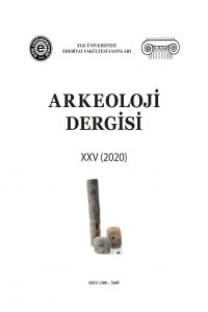2015 Yılı Bayraklı Höyük Kazıları: Tunç Çağı Çalışmalarına Dair Ön Rapor
[BAYRAKLI MOUND EXCAVATIONS IN 2015: A PRELIMINARY REPORT ON THE BRONZE AGE STUDIES]
Bayraklı-Tepekule Mound (Old Smyrna) is located on the slope of Yamanlar Mountain in İzmir province and covers an area of approximately 100 hectares, which is surrounded by the modern city today. The excavations since 1948 indicate a long-standing background of the archaeological projects up to the present. However, the prehistoric periods of the mound are still very little known since the previous projects were mainly engaged in the Hellenic period by reason of the fact that a large Hellenic city remains standing on the mound. New excavations in Bayraklı have been proceeding since 2014 under the direction of Prof. Dr. Cumhur Tanrıver from Ege University. A team, the present authors also participated, conducted the prehistoric excavations for a month in August 2015. Area H was chosen for the beginning of the prehistoric excavations, for the upper layers (Iron Age) of this trench was removed during the old excavations period. According to the publications, the earliest date of this trench is around 1050-1000 BC which corresponding to the Early Iron Age. Excavations in Area H enlighten the knowledge about Bronze Ages. Totally, three layers were uncovered in this trench. The upper layer, named as Layer I, represented by the stone architectural elements and a pithos. The stones were used for supporting the pithos in three directions. Some complete vessels were found as in situ on this stone filling area. The pottery obtained from this area is characterized by the course- handmade and dark faced pottery. Layer II and III are represented by the mudbrick structures such as ovens and basin like places. The most characteristic features of the Level II pottery is the existence of light surface treatment in the color of buff or cream. However, the earliest layer (Layer III) points the occurrence of red slipped pottery for the first time. As a conclusion, 2015 excavations in the Area H provide data, dating to the Late and Middle Bronze Ages, in total of three layers. As mentioned above, the exact dates of these layers will be understand after detailed examinations on pottery and radiocarbon analysis. Since excavated area is very little, it is hard for now to predict the general settlement plan during these periods. We hope to have a comprehensive knowledge with the help of the excavations in a wider area in the next year.
___
- Akurgal 1950: E. Akurgal, "Bayraklı Kazısı Ön Rapor", Ankara Üniversitesi Dil ve TarihCoğrafya Fakültesi Dergisi VIII/1-2, Ankara: 1-51.
- Akurgal 1993: E. Akurgal, Eski Çağ'da Ege ve İzmir, İzmir.
- Akurgal 1997: E. Akurgal, Eski İzmir I. Yerleşme Katları ve Athena Tapınağı, Ankara.
- Aykurt 2013: A. Aykurt, "An Updated Assessment on Western Anatolian Middle Bronze Age Chronology in the Light of Excavtions of the İzmir Region", Colloquium Anatolicum XII: 37-77.
- Bayne 2000: N. Bayne, "The Grey Wares of North-West Anatolia in the Middle and Late Bronze Age and the Early Iron Age and Their Relation to the Early Greek Settlements", Asia Minor Studen 37, Bonn.
- Cook 1958/1959: J. M. Cook, "Old Smyrna, 1948-1951", BSA 53/54, 1958/59, 1-34.
- Erdem 2016a: A. U. Erdem, "İzmir-Bayraklı Höyük'te Prehistorik Çalışmalar-2015", Türk Eskiçağ Bilimleri Enstitüsü Haberler Dergisi 41: 27-28.
- Erdem 2016b: A. U. Erdem, "Bayraklı/Smyrna Makaraları ve Ege Arkeolojisi'ndeki Yeri", TÜBA-AR 19: 69-77.
- Erkanal 2008: H. Erkanal, "Geç Tunç Çağ'da Limantepe", A. Erkanal, S. Günel, U. Deniz (Ed.) Batı Anadolu ve Doğu Akdeniz Geç Tunç Çağı Kültürleri Üzerine Yeni Araştırmalar, Ankara, 91-100.
- Günel 1999: S. Günel, Panaztepe II. M.Ö. 2 Bine Tarihlendirilen Panaztepe Seramiğinin Batı Anadolu ve Ege Arkeolojisindeki Yeri ve Önemi, Ankara.
- Pavuk 2002: P. Pavuk, "Troia VI and VIIa. The Blegen Pottery Shapes: Towards a Typology", Studia Troica 12: 35-71.
- Pavuk ve Rigter 2006: P. Pavuk, W. Rigter, "Goblets, Schüsseln und Kratere- Die Keramik der Perioden Troia VI und VIIa", In: M. O. Korfmann (Ed.) Trioa. Archäologie eines Seidlundshügels und seiner Landschaft, Mainz: 231-240.
- Pavuk 2010: P. Pavuk, "Minyan or Not. The Second Millennium Grey Ware in Western Anatolia and Its Relation to Mainland Greece", In: A. PhilippaTaucais, G. Taucais, S. Vautsaki, J. Wright (Eds.) Mosehelladica. The Greek Mainland in the Bronze Age, Atina.
- Şahoğlu 2007: V. Şahoğlu, "Çeşme-Bağlararası. A New Excavation in Western Anatolia", In: F. Felten, W. Gauss, R. Smetana (Eds.) Middle Helladic Pottery and Synchronisms. Proceedigs of the International Workshop held at Salzburg, Wien, 309- 322.
- ISSN: 1300-5685
- Yayın Aralığı: Yılda 2 Sayı
- Başlangıç: 1991
- Yayıncı: Ege Yayınları
Sayıdaki Diğer Makaleler
2015 yılı Bayraklı Höyük Kazıları: M.Ö. 5. ve 4. yüzyıl Sivil Mimari Yapıları Çalışması Ön Raporu
A vaulted tomb in Isparta/Çünür and its finds
Kappadokia Komana'sı Hellenistik ve Roma Dönemi Mutfak ve Pişirme Kapları
Klaros'tan Bir Oinokhoe Parçası Üzerindeki Sahnenin İkonografik İncelemesi
2015 Yılı Bayraklı Höyük Kazıları: Tunç Çağı Çalışmalarına Dair Ön Rapor
Cumhur TANRIVER, Aylin Ü. ERDEM
Observations on the "Colonization" of Erythrae by "Minoans" and "Ionians"
Menias'ın İdyma'daki Oda Mezarı
Mezar Hediyesi Olarak Mylasa Mastosları
